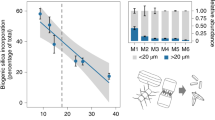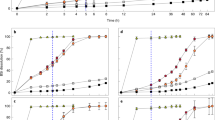Summary
In order to simulate the fate of biogenic silica generated in the surface waters of the Southern Ocean, the dissolution of silica frustules was studied for seven natural assemblages of diatoms, collected during summer 1984 in the Indian sector, and two typical Antarctic diatoms (Nitzschia cylindrus and Chaetoceros deflandrei), following the procedure of Kamatani and Riley (1979). For mean summer conditions in the surface waters of the Southern Ocean (2<T°C<12; 7.5<pH<8) rate coefficients of dissolution range from 2.2 to 18.5x10-3d-1 for the natural assemblages. The silica frustules trapped by fecal pellets and by gelatinous aggregates, and rapidly transported through the cold waters of the Circumpolar Current, reach the sea bottom of either the continental shelves of the abysses without loosing much of the initial amount of silica (less than 10%). A model based on Stokes' law, modified to take in account of non ideal conditions and of the upwelling rate, is used in order to simulate the fate of silica of unaggregated particles settling down in the cold waters of the Antarctic Divergence. It supports the ideas that 1-the cycle of siliceous particles which radii are <2 μm (i.e., of a part of the nanoplankton) is completely achieved in the surface layer, 2-although the biogenic silica of large unaggregated particles (radii over 25 μm) may reach the seabottom (within one month to a few years) without complete dissolution, the main explanation for the accumulation of biogenic silica on Antarctic abysses remains transport by fecal pellets and gelatinous aggregates.
Similar content being viewed by others
References
Bodungen B von, Smetacek VS, Tilzer MM, Zeitzschel B (1986) Primary production and sedimentation during spring in the antarctic peninsula region. Deep-Sea Res 33:177–194
Brun-Cottan JC (1976a) Contribution à l'étude de la granulométrie et de la cinétique des particules mrines. Thèse D es S Univ P et M Curie, Paris, pp 200
Brun-Cottan JC (1976b) Stokes settling and dissolution rate model for marine particles as a function of size distribution. J Geophys Res 81:1601–1606
Bzrezinski MA (1987) Physiological and environmental factors affecting diatom species competition in a Gulf Stream warmcore ring. Ph D Diss, Oregon State University, Corvallis, pp 284
Dietlin B (1982) Contribution à l'étude de l'influence de la turbulence sur la vitesse de sédimentation des particules marines. Thèse D Ing, Univ P et M Curie, Paris, pp 294
Dunbar RB (1984) Sediment trap experiments on the antarctic continental margin. Antarct J US 19:70–71
Dunbar RB, Anderson JB, Domack EW, Jacobs SS (1985a) Oceanographic influences on sedimentation along the antarctic continental shelf. Antarct Res Ser 43:291–312
Dunbar RB, Macpherson AJ, Wefer G (1985b) Water-column particulate flux and seafloor deposits in the Bransfield Strait and southern Ross Sea, Antarctica. Antarct J US Rev, pp 90–100
Geissler U (1958) Das membranpotential einiger diatomeen und seine Bedeutung für die lebende kieselalgenzelle. Mikroskopie 13:145–172
Goldberg ED (1952) Iron assimilation by marine diatoms. Biol Bull 102:243–248
Gordon AL, Taylor HW (1975) Heat and salt balance within the cold waters of the world ocean. Numerical models of ocean circulation. Nat Acad Sci, Whashington DC, pp 54–56
Harvey HW (1937) The supply of iron to diatoms. Mar Biol Assoc UK 22:205–219
Hubbard LML, Riley JP (1984) Kinetics studies of the rate of dissolution of silica and diatom tests in seawater. J Oceanogr Soc Jpn 40:148–154
Hurd DC (1973) Interactions of biogenic opal, sediment and sewater in the Central Equatorial Pacific. Geochim Cosmochim Acta 37:2257–2282
Iler RK (1955) The colloidal chemistry of silica and silicates. New York, Cornell University Press, pp 324
Ives KJ (1959) The significance of surface electrical charge on algae in water purification. J Biochem Microbiol Tech Eng 1:37–47
Jacques G, Tréguer P (1986) Ecosystèmes pélagiques marins. Masson, Paris New York, pp 250
Kamatani A (1982) Dissolution rates of silica from diatoms decomposing at various temperatures. Mar Biol 68:91–96
Kamatani A, Riley JP (1979) Rate of dissolution of diatom silica walls in seawater. Mar Biol 55:29–35
Kamatani A, Ejiri N, Tréguer P (1988) The dissolution kinetics of diatom ooze from the Antarctic area. Deep-Sea Res 35:1195–1203
Kamatani A, Ridley JP, Skirrow G (1980) The dissolution of opaline silica of diatom tests in seawater. J Oceanogr Soc Jpn 36:201–208
Ledford-Hoffman PA, De Master DJ, Nittrouer CA (1986) Biogenicsilica accumulation in the Ross Sea and the importance of Antarctic continental-shelf deposits in the marine silica budgets. Geochim Cosmochim Acta 50:2099–2110
Lewin JC (1961) The dissolution of silica from diatom walls. Geochim Cosmochim Acta 21:182–198
Litsizin AP (1972) Sedimentation in the World Ocean. Soc Eco Min Paleo (special issue) 17:218
McCave IN (1975) Vertical flux of particles in the ocean. Deep-Sea Res 22:491–502
MacNown JS, Malaika J, Pramanik HR (1951) Particle shape and settling velocity. Proc Int Hydr Res, 4th Meeting, Bombay, pp 511–522
Martin JH, Knauer GA (1973) The elemental composition of plankton. Geochim Cosmochim Acta 37:1639–1653
Nelson DM, Goering JJ (1977) Near-surface dissolution in the upwelling region off northwest Africa. Deep-Sea Res 24:65–73
Nelson DM, Gordon LI (1982) Production and pelagic dissolution of biogenic silica in the Southern Ocean. Geochim Cosmochim Acta 46:491–501
Nelson DM, Smith WO (1986) Phytoplankton bloom dynamics of the western Ross Sea ice edge II-Mesoscale cycling of nitrogen and silicon. Deep-Sea Res 33:1389–1412
Nelson DM, Smith WO, Gordon LI, Huber BA (1987) Spring distributions of density of nutrients and phytoplankton biomass in the ice edge zone of the Weddell Sea. J Geophys Res 92:7181–7185
Pichon JJ (1985) Les diatomées traçeurs de l'évolution climatique et hydrologique de l'Océan Austral au cours du dernier cycle climatique. Thèse D es S, Univ Bordeaux, 250 pp
Priddle J, Heywood RB, Theriot E (1986a) Some environmental factors influencing phytoplankton in the Southern Ocean around South Georgia. Polar Biol 5:65–79
Priddle J, Hawes I, Ellis-Evans JC, Smith TJ (1986b) Antarctic aquatic ecosystems as habitats for phytoplankton. Biol Rev 61:199–238
Richards FA (1981) Coastal upwelling. AGU, Washington 544 pp
Schrader HJ (1971) Fecal pellets: role in sedimentation of pelagic diatoms. Science 174:55–57
Smetacek VS (1985) Role of sinking in diatom life-history cycles: ecological, evolutionary and geological significance. Mar Biol 84:239–251
Suess E, Ungerer CA (1981) Element and phase composition of particulate matter from the circumpolar current between New Zealand and Antarctica. Oceanol Acta 4:151–160
Tréguer P, Le Corre P (1975) Manuel d'analyses des sels nutritifs dans l'eau de mer. Utilisation de l'Auto Analyzer II Technicon. Univ Bretagne Occidentale, Brest, 110 pp
Tréguer P, Jacques G (1986) L'Océan Antarctique. La Recherche 178:746–755
Tsunogaï S, Noriki S, Harada K Kurosaki T, Wanatabe Y, Maedaa M (1986) Large but variable particulate flux in the Antarctic Ocean and its significance for the chemistry of Antarctic Water. J Oceanogr Soc Jpn 42:83–90
Urrere MA, Knauer GA (1981) Zooplankton fecal pellet fluxes and vertical transport of particulate organic material in the pelagic environment. J Plankton Res 3:369–387
Van Bennekom AJ (1981) The role of aluminium in the dissolution kinetics of diatom frustules. In: Ross R (ed) Proc 6th Diatom Symp 1980. Koeltz, Koenigstein (FRG), pp 445–454
Van Bennekom AJ, Van Der Gaast SJ (1976) Possible clay structures in frustules of living diatoms. Geochim Cosmochim Acta 40:1149–1152
Van Bennekom AJ, Berger GW, Van Der Gaast SJ, De Vries RTP (1988) Primary productivity and the silica cycle in the Southern Ocean (Atlantic sector). Palaeogeog Palaeochim Palaeoecol (special issue) (in press)
Walton Smith FG (1974) Handbook of Marine Science 19, CRC Press Pub I, pp 64–65
Wollast R (1974) The silica problem. In: Goldberg ED (ed) The Sea. Wiley and Sons, New York, pp 359–392
Author information
Authors and Affiliations
Rights and permissions
About this article
Cite this article
Tréguer, P., Kamatani, A., Gueneley, S. et al. Kinetics of dissolution of Antarctic diatom frustules and the biogeochemical cycle of silicon in the Southern Ocean. Polar Biol 9, 397–403 (1989). https://doi.org/10.1007/BF00442531
Received:
Accepted:
Issue Date:
DOI: https://doi.org/10.1007/BF00442531




